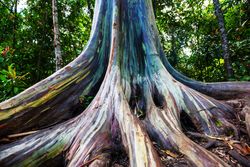
Popular for its multitude of colors, the rainbow eucalyptus tree thrives in Hawaii and other moderate climates in the northern hemisphere. You’ll see this eye-catching tree when you go on a Road to Hana tour because it was introduced in the late 1920s as part of a botanical restoration effort. Here’s what you need to know before embarking on an adventure and spotting this unique species.
A Brief Guide to Rainbow Eucalyptus Trees
How tall is the tree?
A rainbow eucalyptus tree can grow from 100 to 250 feet tall and about 6 feet in diameter in its native habitat. Trees growing in the Pacific Islands tend to be taller, while those in the continental United States tend to be shorter.
Where does the tree grow?
The rainbow eucalyptus tree is a northern hemisphere tree, and is the only eucalyptus variety that grows in the region. This tree is common in the Philippines, Indonesia, and New Guinea, as well as the major islands of Hawaii. It also grows in parts of the mainland, including California, and Florida, which tend to be frost-free and have moderate temperatures year-round.
Where did it get its name?
 This tree gets its name from the multicolored bark that it produces. Like other trees, this species’ bark starts as a light brown shade, but it sheds over time.
This tree gets its name from the multicolored bark that it produces. Like other trees, this species’ bark starts as a light brown shade, but it sheds over time.
Shedding the first layer showcases a light green color that’s hiding underneath. New layers of bark reveal even more colors, including red, purple, blue, and pink. Once the shedding process is complete, the bark returns to its light brown shade.
How is this tree used?
Although you’ll see rainbow eucalyptus trees in nature during your Hawaii tour, you’ll also spot them in landscaping because of their vibrant, multicolored bark and abundant shade.
The tree is also used for lumber or plywood. You might find it incorporated into a variety of pieces, including cabinets, tables, and joinery. Additionally, rainbow eucalyptus is a popular pulpwood, meaning it is used to make paper. The paper, however, turns out white instead of any of the colors from the bark.
Respect Private Property
Avoid exploring rainbow eucalyptus trees that are located on private property. For example, there is a grove of rainbow eucalyptus trees. along the Hana Highway at about mile marker 7. This area is fenced off and clearly marked with no trepassing signs. You can see several trees at the Keanae Arboretum or along the Pipiwai Trail without having to trespass onto private property to get that perfect photo.
Get close to rainbow eucalyptus trees and Maui’s stunning mountain and coastal views with Hoaloha Jeep Adventures. They offer the only private Jeep tours on Maui, so you get a truly personalized travel experience. You’ll learn about the island’s land formations and geology while traveling through scenic areas. Learn about their Maui tours on the website and call (888) 493-4060 to book this unforgettable adventure.
About the Business
Have a question? Ask the experts!
Send your question

